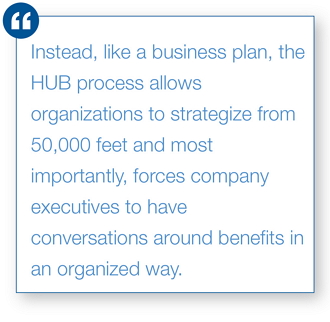Act purposefully - and with flexibility - when initiating your benefits plan re-design.
For most organizations – small, medium
and large -- employee benefits are a top five expense, often costing even more
than the office lease. In 2014, the average annual premiums for
employer-sponsored health insurance plans were $6,025 for single coverage and
$16,834 for family coverage.[1]
The Patient Protection and Affordable Care
Act (PPACA) is about to make cost management even more challenging. In light of
the recent Supreme Court decision, King
v. Burwell, looming PPACA
deadlines for IRS reporting, the Employer Mandate and the Cadillac Tax will debut as planned.
“Preparing Cadillac Tax projections for
businesses is very telling,” said Mike Barone, National President, Employee
Benefits, HUB International. “Relative to historic trends, most employers will
need to achieve a lower compounded growth rate in their renewal to avoid
triggering a Cadillac Tax.”
Creating a strategic 3- to 5-year
employee benefits plan is more important now than ever.
Looking
3 to 5 years out
In order to help businesses meet the
upcoming PPACA mandates in a proactive and timely manner, HUB created an
employee benefits strategic planning process that streamlines and prioritizes plan
design changes over the next 3 to 5 years.
 “You don’t want to change every element
of your employee benefits plan every year,” said Barone. “Instead, like a
business plan, the HUB process allows organizations to strategize from 50,000
feet and most importantly, forces company executives to have conversations
around benefits in an organized way.”
“You don’t want to change every element
of your employee benefits plan every year,” said Barone. “Instead, like a
business plan, the HUB process allows organizations to strategize from 50,000
feet and most importantly, forces company executives to have conversations
around benefits in an organized way.”
Just like each organization’s key
performance indicators (KPIs), goals and objectives are different, so too are their
benefits plan. For this reason, the HUB process stresses flexibility, with gradual
change over the first few years. This applies to every category of employee
benefits. Here is a sampling of considerations from the HUB 3- to 5-year
process:
Value
added/voluntary products – Companies moving
from rich health care plans to high-deductible plans will want to consider
offering voluntary benefits, including hospital indemnity plans, accident
policies and more, to maintain a high level of offerings for employees. How will
you “make it up” to your employees so they don’t feel their benefits are being
reduced?
Funding – With PPACA
expanding the definition of small businesses to 99 lives, more businesses will
consider self-insurance options than ever before. What is the ideal mechanism
for your business to fund employee benefits?
Contributions – Health care
reform will force employers to reconsider their employee contribution strategies.
Will you continue with the traditional, flat dollar methodology, move to a new salary-based, tiered approach, or
a defined contribution in which employees are given one lump sum each year to
allocate as they choose?
Communications –
The
traditional open enrollment packet isn’t enough to introduce a new way of thinking
about benefits to your employees. Instead, proactive organizations will create
a communications campaign around the new benefits, including the use of e-guides
and online tools, like private exchange-decision support. How will you drive
engagement, adoption, and understanding as well as proof of offer and
declination for your new employee benefits?
“When your business creates a new
product, you create a marketing campaign around it that may include digital
marketing, brochures and training a sales force with talking points. How much
marketing and communications money do you allocate for your employee benefits
plan to show employees how to leverage and use it?” said Barone. “You’re
spending an average of $10,000 per employee per year on benefits, but you likely
spend a fraction of the money effectively communicating it.”
Compliance – The PPACA will
usher in many new reporting requirements. Using the 3 to 5 -year strategy to
map out your specific compliance requirements (depending on your state, size,
industry, etc.) will be critical. How are you going to prove and certify your
benefits compliance?
Technology– Technology will play a critical role in your long-term benefits administration goals
to ensure the solutions you choose establish, prove, track and maintain
compliance today, while supporting your business strategies of tomorrow. How are you going to present new health
care plans, add voluntary benefits, implement a wellness program, change how
you communicate with employees about their benefits, meet new compliance and reporting
regulations, change how your employee benefits are funded and how you
contribute to them financially?
Making
it all a reality
Regardless of what the organization’s
ultimate benefits re-design looks like, being purposeful and flexible will ease
the employer and employee transition.
“Once
we develop a strategy, each business can decide which lane of the freeway they
want to drive in – moving quickly in the fast lane or taking the slow lane and
implementing changes over time,” said Barone. “Customization of the 3 to 5 year
framework, specific to each organization, is key.”
Critical to this flexibility is an
annual evaluation of what worked, what didn’t and what industry or inter-office
changes have occurred that will cause the employee benefits strategy to evolve.
Conducting an annual “state of the union” will determine the necessary tweaks
going forward and will ultimately keep the benefits rollout on track with the
predetermined goals from day one.
For more information on the HUB
employee benefits strategic planning process, contact your HUB employee
benefits consultant.
[1]
2014 Employer Health Benefits Survey, Kaiser Family Foundation.